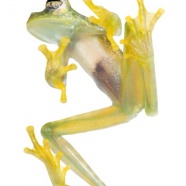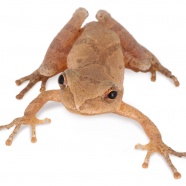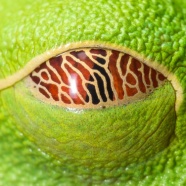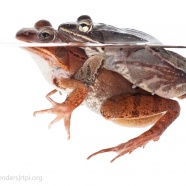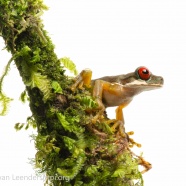Ghost Glass Frogs!
Researchers from the Roger Tory Peterson Institute of Natural History (RTPI) have been monitoring these Ghost Glass Frogs and other amphibian species for more than two decades – not only to keep these frogs from extinction, but also to learn how the recovering populations were able to survive such catastrophic declines. Hopefully this information will help us as we try to find ways to help other endangered species as well. Stay tuned for more footage from our adventures in the tropics!
Read MoreSpring Peepers
Spring Peepers are a type of small tree frog. Truthful to their name, they emerge from hibernation in early spring. Soon after, the males – often hundreds at a time – will take over wetlands and call on warm and rainy nights to stake out a territory and attract a mate. Their surprisingly loud “peep” calls are usually produced from a safe location hidden in dense vegetation, and it can be difficult to spot them. An inflatable vocal sac on their throat serves as an amplifier, which allows them to call very loudly. The sound produced by a chorus of these inch-long frogs can be truly deafening...
Read MoreOpening Eyes, Minds, and Hearts to Earth’s Biodiversity
Roger Tory Peterson traveled the world to explore, discover, and document its flora and fauna. He applied his artistic talents to describe and illustrate plants and animals in far-away regions to make their existence known to a broad audience, while his biological observations and knowledge supported conservation efforts and helped elicit positive environmental change. Like Peterson, RTPI Director Twan Leenders likewise uses his artistic skills to increase awareness and appreciation for the organisms that he studies, both locally and abroad. Leenders is currently in Costa Rica conducting...
Read MoreFrost Free Frogs?
“The animal kingdom relies on staggering evolutionary innovations to survive winter.” Bernd Heinrich renowned biologist and author – made this statement in his bestselling book entitled “Winter World”. The Wood Frog (Rana sylvatica) is a true embodiment of this statement; these tiny amphibians can survive for weeks with an incredible two-thirds of their body water completely frozen—to the point where they are essentially solid frogsicles! The adaptation that enables this remarkable feat is known as a cryoprotectant – a substance that prevents damage to cells and tissues during...
Read MoreTreasures of the Tropics
In less than two weeks an RTPI crew will be headed to Costa Rica again, this time with students from the Forman School. Students will participate in a variety of research projects, including migratory bird banding and monitoring endangered and recovering amphibian populations, such as this Rufous-eyed Brook Tree Frog (Duellmanohyla rufioculis). Stay tuned for more information soon!
Read More



